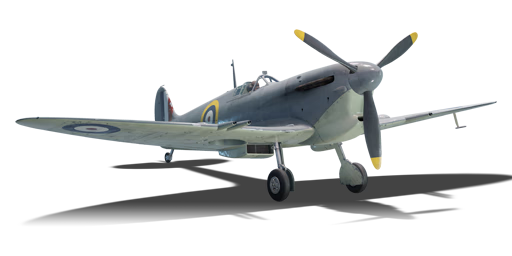



In order to adapt the Spitfire Mk Vc for overseas operations, such as in Malta, North Africa, Burma, and Australia, the aircraft was equipped with a large air filter under the nose, as well as other modifications such as a larger oil coolant tank and survival gear behind the pilot's seat. The restricted airflow to the supercharger reduced the performance of the engine, but this was deemed acceptable. A naval camouflage was also applied to better protect the aircraft while flying over the Mediterranean and Indian Ocean.
In the game since the start of the Open Beta Test, the Mk Vc/trop will commonly be matched against planes such as the Bf 109 G-2/trop, which performs better in the vertical (climbing/diving), or the A6M5, which performs better in the horizontal (turning). While this aircraft faces tricky opposition, it is far from helpless as one might expect from what is essentially the airframe of a Spitfire Mk Ia. The Spitfire Mk Vc/trop has two major advantages over its opposition: turn performance, engine performance below 3,000 m, and armament. The plane is blessed with a Merlin 45M engine that grants it phenomenal acceleration below that altitude compared to German opposition, as well as a hard-hitting armament of four Hispano Mk II cannons that gives it an exceptionally high burst mass of 5.17 kg/s, putting it on the same level as the Fw 190 A-5.
flaps
flaps
flaps
brake
| Belt | Belt filling | Armor penetration (mm) at a distance: | |||||
|---|---|---|---|---|---|---|---|
| 10 m | 100 m | 500 m | 1000 m | 1500 m | 2000 m | ||
| HEI/SAP-I/T | 22 | 20 | 14 | 9 | 6 | 4 | |
| AP-T/HEI/SAP-I | 37 | 35 | 25 | 16 | 10 | 7 | |
| T/HEI/SAP-I/HEI/SAP-I | 22 | 20 | 14 | 9 | 6 | 4 | |
| AP-T/T/HEI | 37 | 35 | 25 | 16 | 10 | 7 | |
| AP-T/SAP-I/HEI/AP-T | 37 | 35 | 25 | 16 | 10 | 7 | |
| HEI/HEI/SAP-I | 22 | 20 | 14 | 9 | 6 | 4 | |












Flight performance | |
|---|---|
Survivability |
|---|
Weaponry |
|---|